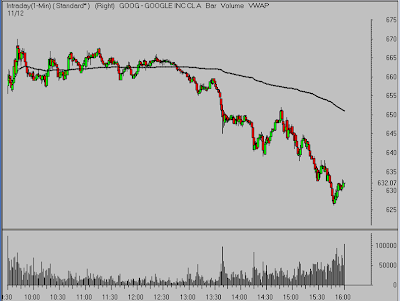Volume Weighted Average Price (VWAP)
People often wonder why the trading volume slows so dramatically during the middle of each trading day. The most common explanation for the midday inactivity is that it is lunch time and while it is certainly part of the reason, it is not as though the specialists and market makers all head out to a liquid lunch and forget about their business for the day. Most serious traders I know eat their lunch at their desk so they don’t miss an opportunity and to maintain a better feel for how their positions are trading.
Consider a market maker with a day order to buy 1 million shares of a stock for an institutional customer. The market maker cannot just go in and buy the full position in the first two hours of the day and then leave his desk to go play golf. Market makers are evaluated by their customers for the quality of trade execution; did they get a fair price for the customer? The most common method of used to analyze the quality of a trade execution is to compare the price the order was filled to the Volume Weighted Average Price (VWAP). The VWAP is calculated by dividing the dollar volume of a stock by the share volume over a given period of time. Simply put, the VWAP is the average price that each share was executed over the period of time being studied. There are several ways to calculate the VWAP in RealTick, the analysis and trading software I use. I prefer VWAP analysis with a moving average, in particular for shorter term day trades on a one day chart of the equity I am trading.
The VWAP is considered to be a fair benchmark for comparison of the institutional trade desks ability to execute trades on behalf of the customer. If the brokerage purchases were made at a price less than VWAP then they did a good job for the customer. If the price paid was greater than the VWAP they may lose that customer for future transactional business. The daily VWAP is a number which changes as orders are transacted at varying prices throughout the day.
Here is a simple example of how an institutional trader might manually execute an order for the purchase of 1 million shares. Let’s say the stock closed the previous day at $40/share. The morning the broker receives the buy order he may offer 5 or 10,000 shares at 39.90 or lower while simultaneously bidding for shares at a lower price. The first trick this broker may use is to show the full size of the offer while only showing 100 shares bid with a larger number of shares “in reserve” meaning that he may be really bidding for 5000 (or any other number they choose) shares. By showing a larger number of shares for sale and a small amount of demand in the pre-market, the broker may induce weaker holders to sell their shares in fear that there could be a real seller looking to get a head start on their
selling that day. This type of activity is pure manipulation and it happens all the time!

The one-minute chart of Google Inc (GOOG) shows a declining VWAP for most of this day, showing the sellers dominance.
If the buying broker can create a mini panic on the open, it is possible that he may be able to scoop up several hundred thousand shares at a very favorable price early on in the day. The risk, of course, is that another buyer calls his bluff and buys the 10,000 shares that he was showing the market on the offer, which would put the market maker short 10,000 shares of a stock he has to buy 1 million shares of that day. Either one of these scenarios is possible. It is part of the market markers
attempt to find, and even motivate by creating fear and triggering stop loss orders, a source of supply so he can begin to fill his purchase order.
If the market maker is able to secure liquidity for 600,000 shares of the order before noon then he knows his job of filling the balance of the order in the afternoon will be easier, particularly if his 600,000 was executed at a favorable price relative to the VWAP at that point of the day.
Read more about VWAP in MY BOOK
.
Be sure to view my end of day videos here each day where I share my thoughts about the market and often mention VWAP.



